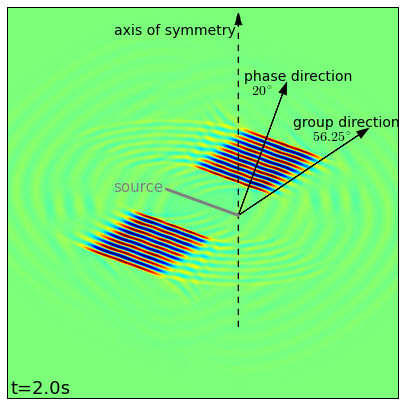In sonic well logging, phase velocity and group velocity are concepts often used. The phase velocity of a wave is the rate at which the phase of the wave propagates in space. Meanwhile, the group velocity of a wave is the velocity with which the overall shape of the waves' amplitudes-known as the modulation or envelope of the wave-propagates through space.
However, in a deviated borehole penetrating a transversely isotropic formation, different kinds of acoustic wave dispersion exist. In such cases the definitions of phase and group velocities are not clear enough and sometimes lead to confusion in the literature. Therefore, it is important to distinguish different velocities in order to correctly evaluate the characteristics of the surrounding formation from sonic logging measurement.
The issue of the phase and group velocity confusion in sonic logging in a borehole penetrating anisotropic formation was recently raised and explained in a comment on a previously published paper “A numerical investigation of the acoustic mode waves in a deviated borehole penetrating a transversely isotropic formation” (LIU Le, LIN Weijun, ZHANG Hailan et al., Sci China-Phys Mech Astron, 2015, 58).
Researchers SU Chang, ZHANG Xiumei, LIN Weijun et al. from the Institute of Acoustics (IOA) of the Chinese Academy of Sciences have furtherly clarified the issue by replying the comment. They have shown that velocity extracted from acoustic logging data in a deviated borehole penetrating transversely isotropic media is the group velocity in the deviating direction.
In a deviated borehole penetrating an anisotropic formation, both the frequency dependent velocity effects and the anisotropic wave propagation effects are present and need to be considered. At a given deviation angle, wave velocity varies with different frequencies. Frequency-by-frequency methods such as slowness travel time coherence (STC) processing yields phase velocity from sonic logging waveforms. At low frequencies, this dispersion effect is low.
For boreholes deviating with different angles, the measured velocity varies with the angle due to the anisotropy property of the formation. The measured velocity at low frequency consists with the group velocity along the deviation angle of the borehole. To understand this, consider waves propagate in a homogenous vertical transverse isotropic (VTI) medium.
Fig. 1 shows a snapshot of a plane Q-SV wave propagating in a homogenous VTI medium, in which it shows that the difference between phase and group directions. If an array of receivers is set along the group direction, the phase velocity yielded from the received waveforms is equal to the group velocity in this direction. When a borehole is added with a source and receiver array, the wave propagating along the borehole has a group direction aligned to borehole axis. So the phase velocity extracted from the received waveforms has a value equal to the group velocity in this direction.

Fig. 1 A snapshot at t=2s of a plane Q-SV wave propagating in a homogenous VTI medium with phase direction from the axis of symmetry (Image by IOA)
To conclude, dipole logs measure group velocity in a deviated well penetrating VTI media when the frequency is low. This discussion may help the community to resolve the confusion of group and phase velocity problems in sonic logging with anisotropic formations.
Reference:
SU Chang, ZHANG Xiumei, LIN Weijun, ZHANG HaiLan, and WANG Xiuming. Reply to “Comment on 'A numerical investigation of the acoustic mode waves in a deviated borehole penetrating a transversely isotropic formation'”. Science China Physics, Mechanics & Astronomy (Vol. 59, No. 8: 684342, August 2016). DOI: 10.1007/s11433-016-0184-y
Contact:
SU Chang
State Key Laboratory of Acoustics, Institute of Acoustics, Chinese Academy of Sciences, Beijing 100190, China
Email: suchang@mail.ioa.ac.cn


